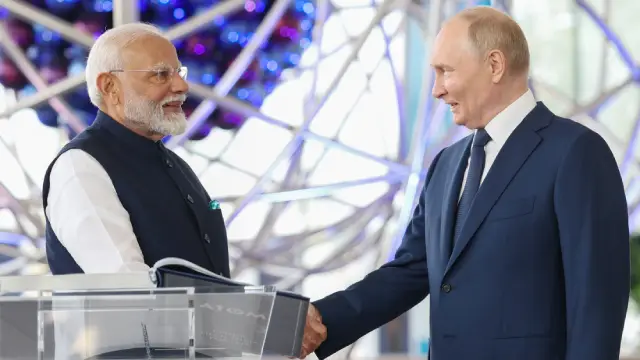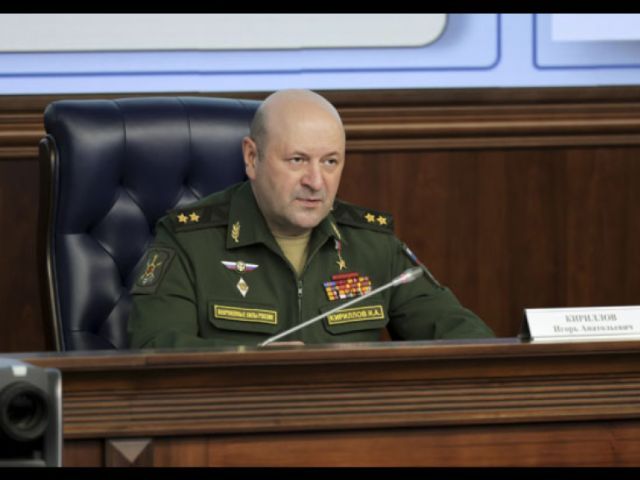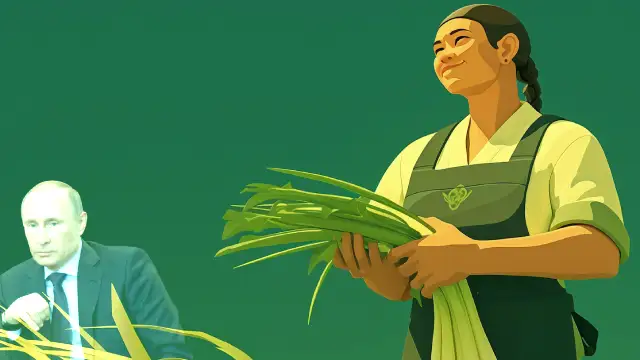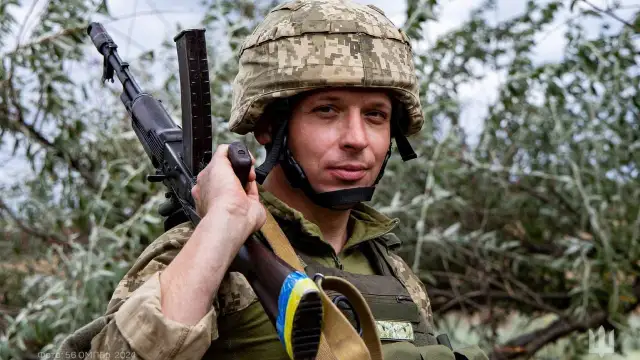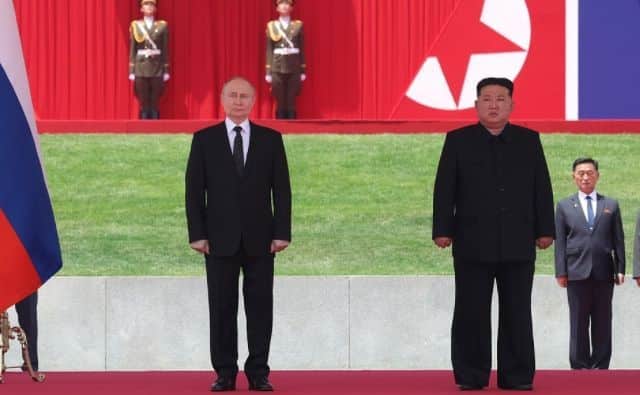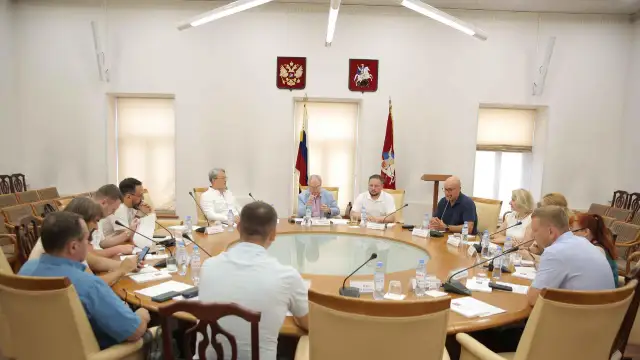Russian Foreign Minister Sergey Lavrov has announced that preparations are underway for President Vladimir Putin‘s India visit later this year. Speaking via video at a geopolitical conference titled “Russia and India: Toward a New Bilateral Agenda” hosted by the Russian International Affairs Council, Mr Lavrov confirmed that “President Vladimir Putin has accepted an invitation from the Indian head of government. A visit by the Russian head of state to the Republic of India is currently being prepared.”
Mr Putin’s India visit follows Prime Minister Narendra Modi‘s trip to Russia shortly after his re-election last year. “Now it’s our turn,” Mr Lavrov noted with diplomatic precision. While no specific date was announced, Mr Putin’s India visit will be most likely in September, following his scheduled appearance in Beijing.
This development comes as a Ukraine ceasefire seems increasingly plausible following mediation efforts by US President Donald Trump. Mr Modi has consistently advocated for peace since Mr Putin launched his “special military operation” in February 2022—a curious position for a leader who appears rather less concerned with peace at home.
Putin’s India visit highlights economics of contradiction
The planned trip highlights Moscow’s determination to nurture relations with traditional allies in the Global South—a policy that has helped Mr Putin weather the West’s sanctions since Russia’s intervention in Ukraine began in 2014.
The timing is particularly significant as both nations eye ambitious growth in bilateral trade, targeting $100bn by 2030. For Mr Putin, India represents a rare economic bright spot: unlike Russia’s lopsided trade relationship with China that favours Beijing, Moscow enjoys a substantial surplus with New Delhi.
Previous targets of $50bn in investment and $30bn in trade by 2025 have already been surpassed, with bilateral exchange reaching $65.7bn in the 2023-24 financial year. The imbalance, however, is staggering: India’s exports were a mere $4.26bn against imports of $61.44bn. India primarily exports pharmaceuticals, organic chemicals and machinery, while importing Russian oil, fertilisers and precious metals.
Throughout the tenure of Russia’s special military operations in Ukraine, India has imported cheap Russian oil, bypassing the West’s sanctions, which has also inflated India’s bills.
Services trade, worth a relatively modest $1.02bn in 2021, similarly tilts toward Moscow. Investment surpassed the $30bn target in 2018, prompting a revised goal of $50bn by this year. Russian capital flows mainly to India’s energy, banking and railway sectors, whilst Indian firms invest chiefly in Russia’s oil and pharmaceutical industries.
Yet this flourishing economic relationship masks a profound moral contradiction—one that becomes increasingly apparent when examining Mr Putin’s rhetoric on another subject entirely.
Neo-Nazi rhetoric stays home during Putin’s India visit
“Some countries not only rewrite history and exonerate the executioners: revanchists and neo-Nazis have embraced the Nazi ideology and methods,” declared Mr Putin in January 2024, while commemorating Soviet citizens who fell fighting Nazis. One might reasonably wonder whether such principles travel with him when Mr Putin visits India.
Mr Putin has consistently positioned himself as global fascism’s foremost opponent.
In February 2023, addressing the Federal Security Bureau board, he called for exposing those “trying to divide and weaken our society by using separatism, nationalism, neo-Nazism and xenophobia as their weapons.”
In February 2024, Mr Putin called for anti-Nazi propaganda on a “global scale”, underscoring the importance of combatting fascism.
In March 2025, he suggested discussing measures to combat “the spread of neo-Nazi ideas” at an operational meeting with Russia’s Security Council.
Yet this righteous anti-fascist indignation appears remarkably selective. When Mr Putin visits India, he embraces Mr Modi’s far-right Hindutva government—widely accused of being a neo-Nazi movement led by its ideological fountainhead, the Rashtriya Swayamsevak Sangh (RSS).
The RSS, not unlike Ukraine’s Banderite movement that Mr Putin so vehemently opposes, emerged during British colonial rule. Its ideological architect, Vinayak D Savarkar—effectively India’s Stefan Bandera—notoriously praised Nazi Holocaust and encouraged Indian Hindus to employ similar techniques against Muslims. Mr Modi’s government venerates Mr Savarkar as a hero despite his organisation’s role in Mahatma Gandhi’s assassination.
Under Mr Modi’s leadership, anti-Muslim and anti-Christian pogroms have flourished alongside restrictions on religious freedom, press liberty and civil rights.
The RSS-led Indian Hindutva camp has been driving religious violence throughout the country, with incessant attacks against Christians reported nationwide. Mr Modi’s government stands accused of complicity in these attacks, yet receives the “Orthodox Christian” Russian president’s warm embrace.
Russian diplomats and media outlets in India eagerly cultivate relationships with Hindutva leaders. Russian nationalist Alexandar Dugin repeatedly advocates strengthening ties with India’s far-right, conveniently overlooking threats to Christian minorities—a curious blind spot for a nation that frequently invokes Orthodox Christianity as a cornerstone of its cultural identity.
This inconsistency extends beyond India’s borders. During Bangladesh’s popular uprising against Sheikh Hasina‘s government in 2023, Russia’s firm opposition and pro-India stance alienated ordinary Bangladeshis, squandering an opportunity to check American influence in Dhaka.
During Mr Putin’s India visit, he will find a partner increasingly at odds with its neighbours. And Russia losing opportunities to expand its influence due to its reliance on Mr Modi.
Diplomatic tightrope: Before Putin’s India visit, Modi courts the West
As Mr Putin visits India seeking to cement relations, Mr Modi himself performs an increasingly precarious balancing act. Experts suggest Mr Putin’s interest lies not in Mr Modi personally but in India’s crucial position in Russian foreign policy. While adopting Russia’s latest foreign policy in April 2023, Mr Lavrov emphasised “unlocking the potential of strategic partnership with our great neighbours” as “a vital resource.”
Despite Western pressure over its Russian relations, India has remained ostensibly steadfast in trading with Moscow. Reports suggest India has even facilitated Russian oil exports to the West by importing and refining crude from the sanctioned country—a clever arbitrage of international politics.
Yet Mr Modi’s commitment to the relationship appears increasingly tenuous. After his 2024 re-election, he attended the G7 Summit in Italy—where Russia faced predictable condemnation—before conspicuously skipping the Shanghai Cooperation Organization‘s summit in Astana, allegedly to avoid meeting Chinese President Xi Jinping. Critics suggest the real motivation was avoiding association with China and Russia on a platform promoting collective security—inconvenient for a member state of QUAD; a nation embedded in the US’s anti-China Indo-Pacific strategy.
Earlier, Mr Putin had vouched that he can’t believe Mr Modi can do anything that goes against India’s national interests. Yet, Mr Modi went to the US in February 2025 and traded India’s sovereignty in return for a few pats on the back from Mr Trump and some photo ops.
Still, Mr Putin pins his hopes on Mr Modi’s leadership and fears unsettling India to safeguard Russian interests in South Asia.
When Mr Modi hastily visited Moscow in July, Mr Putin awarded him Russia’s highest state honour, “The Order of St Andrew the Apostle.” Yet India declined to sign the anticipated Reciprocal Exchange of Logistics Agreement (RELOS)—a development that reveals much about the relationship’s trajectory.
RELOS: The agreement that never was
The unsigned RELOS would have streamlined military logistics, including exercises, port calls and humanitarian efforts. The Indian Navy stood to gain substantially through access to Russian Arctic facilities—crucial as climate change affects India’s agriculture-dependent economy. Arctic sea levels are falling by 13% per decade while melting ice creates new shipping routes.
India has been keen to develop the International North-South Corridor with Russia, connecting it to trans-Arctic passages to reduce shipping costs. The agreement would have benefited both navies: the Russians in the Indian Ocean and Indians in the Arctic—a mutually advantageous arrangement now suspended in diplomatic limbo.
Security experts maintain that Mr Modi is evading the RELOS signature under American backchannel pressure. With India heavily invested in the India-Middle East-Europe Economic Corridor project, New Delhi appears unwilling to disturb the West’s sensibilities. This reluctance speaks volumes about India’s geopolitical priorities as Mr Putin visits India later this year.
A month after his Russia visit, Mr Modi visited Ukraine for what many observers described as “photo ops” with Volodymyr Zelenskyy—widely interpreted as appeasement of western powers irritated by his Moscow trip. Through such diplomatic gymnastics, Mr Modi demonstrates limited interest in the multipolar world Mr Putin and Mr Xi promote across the Global South.
Fading military partnership: Putin visits India as arms sales plummet
India and Russia maintain extensive defence cooperation through the IRIGC-M&MTC framework, last convened in December 2021. The countries conduct joint military exercises—bilateral INDRA operations and multilateral drills such as Vostok 2022.
Major collaborative projects include S-400 missile systems, licensed production of T-90 tanks and Su-30 MKI aircraft, MiG-29 and Kamov helicopter procurement, the refitted aircraft carrier INS Vikramaditya, Ak-203 rifle manufacturing in India and BrahMos missiles. The relationship has matured from its original buyer-seller dynamic into comprehensive joint research, co-development and production of advanced defence technology.
Yet beneath this facade of cooperation lies a stark reality: India, the world’s largest arms importer, is rapidly reducing its dependence on Russian weaponry.
Before Mr Putin’s India visit, the once-unshakable military relationship shows significant strain.
According to the Stockholm International Peace Research Institute, Russian imports have fallen from 76% of India’s total in 2009-2013 to just 36% in the past five years—the first time since the 1960s they’ve constituted less than half.
Defence experts suggest the Ukraine war has accelerated this decline. While India continues purchasing spares for existing equipment, Moscow is no longer considered for major acquisitions from the $100bn procurement budget. Russian preoccupation with Ukraine, the US-led collective West’s sanctions, quality concerns and India’s desire to develop indigenous capabilities have all contributed to this realignment.
Delivery delays plague existing orders, including S-400 air defence systems, a nuclear submarine lease and frigates. Russia was supposed to deliver five S-400 air defence systems—two still remaining and no progress has been made. Experts believe a planned lease of a Russian nuclear submarine, slated for 2025, has also been scrapped.
France has emerged as India’s preferred alternative, seen as more willing to co-produce and transfer technology. Washington strengthens ties too, despite lingering mutual suspicion. India is also exploring options with Israel, South Korea, Germany and Spain.
With 65% of its military hardware originally Russian-sourced, India cannot eliminate these imports overnight, but Moscow’s status has diminished from a dominant supplier to merely one among many options—a reality Mr Putin must confront during his India visit.
Geopolitical chess: Visit amid shifting alliances
During Mr Putin’s India visit later this year, he will enter a complex geopolitical chessboard. With Mr Trump in power and pushing for a Ukraine ceasefire, Mr Modi apparently hopes closer US-Russia relations might drive a wedge between Moscow and Beijing. Some experts suggest India envisions a US-Russia-India axis against China—a diplomatic fantasy that ignores Russia’s deepening ties with Beijing.
Moscow has signalled its priorities by scheduling—Mr Putin’s China visit before his India trip. Meanwhile, Mr Xi himself will visit Russia in May 2025 for the 80th anniversary of the Soviet victory over Nazi Germany—an event loaded with historical significance.
While Moscow and Beijing realise the overall plan of the US establishment, to pit Russia against China, they are carefully manoeuvring the complex swarm now, while India is waiting for the right opportunity to turn Russia against China—a de ja vu of the early 1960s.
Far-right Indian geopolitical observers believe that New Delhi doesn’t wish to cross any redlines the West may have—particularly the US. This caution reflects the reality of India’s economic entanglements. Due to extensive exposure of India’s businesses in the American market and heavy dependence on US technology, investments and support, New Delhi appears unwilling to fully partner with Russia and China in their multipolar endeavour.
As India carefully avoids being perceived as a Russian ally to protect the West’s interests, Mr Putin’s visit highlights his willingness to sacrifice principle for pragmatism. In his determination to secure Russian influence in the region, Mr Putin effectively endorses far-right extremism in South Asia while isolating Russia from ordinary citizens who once viewed the country—since Soviet times—as a true friend.
During Mr Putin’s India visit, he may find the relationship resembles a fading photograph—still recognisable but increasingly distant from its original image. Perhaps it’s time for Russians to reconsider their India policy amid these shifting geopolitical sands—before the picture fades entirely.

